Organic Manure Significantly Promotes the Growth of Oilseed Flax and Improves Its Grain Yield in Dry Areas of the Loess Plateau of China
Abstract
:1. Introduction
2. Materials and Methods
2.1. Experimental Site
2.2. Experimental Design
2.3. Measurement and Calculation
2.3.1. Emergence Rate
2.3.2. Plant Height and Stem Diameter
2.3.3. Dry Matter Accumulation
2.3.4. Grain Filling
2.3.5. Grain Yield and Its Components
2.4. Statistical Analyses
3. Results
3.1. Seedling Emergence Rate
3.2. Plant Height and Stem Diameter
3.3. Dry Matter Accumulation and Distribution
3.4. Grain Filling Characteristics
3.4.1. Filling Rate
3.4.2. Filling Characteristic Parameters
3.5. Yield and Components
3.6. Correlation Analysis between Grain Yield and Its Components
3.7. Economic Benefit Analysis
4. Discussion
5. Conclusions
Author Contributions
Funding
Data Availability Statement
Conflicts of Interest
References
- Kulma, A.; Zuk, M.; Long, S.; Qiu, C.; Wang, Y.; Jankauskiene, S.; Preisber, M.; Kostyn, K.; Szopa, J. Biotechnology of fibrous flax in Europe and China. Ind. Crops Prod. 2015, 68, 50–59. [Google Scholar] [CrossRef]
- Xue, L.; Zhao, X.; Cao, Z. The influence factors of China’s flax import and export trade-Empirical analysis based on constant market share model. Mark. Wkly. 2022, 35, 77–81+145. (In Chinese) [Google Scholar]
- Qiao, H.; Zhang, W.; Zhang, L. Investigation and Analysis report on Flax Market and Industry in China. Agric. Prod. Mark. 2021, 14, 49–51. (In Chinese) [Google Scholar]
- Guo, J.; Fan, J.; Zhang, F.; Zhang, F.; Yan, S.; Zheng, J.; Wu, Y.; Li, J.; Wang, Y.; Sun, X.; et al. Blending urea and slow-release nitrogen fertilizer increases dryland maize yield and nitrogen use efficiency while mitigating ammonia volatilization. Sci. Total Environ. 2021, 790, 148058. [Google Scholar] [CrossRef] [PubMed]
- Wang, Y.; Zhu, Y.; Zhang, S.; Wang, Y. What could promote farmers to replace chemical fertilizers with organic fertilizers? J. Clean. Prod. 2018, 199, 882–890. [Google Scholar] [CrossRef]
- Khem, B.; Hirai, Y.; Yamakawa, T.; Mori, Y.; Lnoue, E.; Okayasu, T.; Mitsuoka, M. Effects of different application methods of fertilizer and manure on soil chemical properties and yield in whole crop rice cultivation. Soil Sci. Plant Nutr. 2018, 64, 406–414. [Google Scholar] [CrossRef]
- Karatay, Y.; Meyer-Aurich, A. A Model Approach for Yield-Zone-Specific Cost Estimation of Greenhouse Gas Mitigation by Nitrogen Fertilizer Reduction. Sustainability 2018, 10, 710. [Google Scholar] [CrossRef]
- Wang, Z.; Geng, Y.; Liang, T. Optimization of reduced chemical fertilizer use in tea gardens based on the assessment of related environmental and economic benefits. Sci. Total Environ. 2020, 713, 136439. [Google Scholar] [CrossRef]
- Lin, C.; Dou, S.; Ei-Rahim, M.; Liu, X.; Wu, D.; Ma, R.; Zhang, Y.; Yin, X.; Tan, C.; Xie, S. Application of Corn Straw and Woody Peat to Improve the Absorption and Utilization of N-15-Urea by Maize. Sustainability 2022, 14, 820. [Google Scholar] [CrossRef]
- Ferdous, Z.; Zulfiqar, F.; Datta, A.; Hasan, A.; Sarker, A. Potential and challenges of organic agriculture in Bangladesh: A review. J. Crop. Improv. 2021, 35, 403–426. [Google Scholar] [CrossRef]
- Baruah, A.; Baruah, K.; Bhattacharyya, P. Comparative Effectiveness of Organic Substitution in Fertilizer Schedule: Impacts on Nitrous Oxide Emission, Photosynthesis, and Crop Productivity in a Tropical Summer Rice Paddy. Water Air Soil Pollut. 2016, 227, 410. [Google Scholar] [CrossRef]
- Liu, L.; Li, H.; Zhu, S.; Gao, Y.; Zheng, X.; Xu, Y. The response of agronomic characters and rice yield to organic fertilization in subtropical China: A three-level meta-analysis. Field Crops Res. 2021, 263, 108049. [Google Scholar] [CrossRef]
- Wei, Z.; Ying, H.; Guo, X.; Zhuang, M.; Cui, Z.; Zhang, F. Substitution of Mineral Fertilizer with Organic Fertilizer in Maize Systems: A Meta-Analysis of Reduced Nitrogen and Carbon Emissions. Agronomy 2020, 10, 1149. [Google Scholar] [CrossRef]
- Jjagwe, J.; Chelimo, K.; Karungi, J.; Komakech, A.; Lederer, J. Comparative Performance of Organic Fertilizers in Maize (Zea mays L.) Growth, Yield, and Economic Results. Agronomy 2020, 10, 69. [Google Scholar] [CrossRef]
- Beltran, A.; Samson, E.; Demafelis, R.; Angeles, D.; Cabahug, R.; Rivera, H. Agronomic and Yield Performance of Sweet Sorghum under Different Fertilizer Schemes. Philipp. J. Crop. Sci. 2019, 44, 87–92. [Google Scholar]
- Witorozec-Piechnik, A.; Matyka, M.; Wolszczak, P.; Oleszek, M. Yield and Selected Physiological Parameters of Maize, Sorghum, and Triticale Depending on Fertilization System. BioResources 2021, 16, 7869–7882. [Google Scholar] [CrossRef]
- Trukhachev, V.; Belopukhov, S.; Dmitrevskaia, I.; Baibekov, I. Changes in flax yield and quality in response to various mineral nutrition. Braz. J. Biol. 2023, 84, e264215. [Google Scholar] [CrossRef]
- Xu, P.; Gao, Y.; Cui, Z.; Wu, B.; Yan, B.; Wang, Y.; Wen, M.; Wang, H.; Ma, X.; Wen, Z. Application of Organic Fertilizers Optimizes Water Consumption Characteristics and Improves Seed Yield of Oilseed Flax in Semi-Arid Areas of the Loess Plateau. Agronomy 2023, 13, 1755. [Google Scholar] [CrossRef]
- Yang, T.; Gao, Y.; Niu, J.; Xie, Y.; Li, C.; Teng, Y.; Li, S.; Ren, J. Effect of meat protein biological organic fertilizer on dry matter accumulation, seed yield and quality of oilseed flax. Agric. Res. Arid. Areas 2017, 35, 128–134. (In Chinese) [Google Scholar]
- Richter, R.; Skarpa, P. Adapting the nutrient regime of soil for sugar beet-precondition for stable and high-quality production. Listy Cukrov. Reparske 2013, 129, 219–222. [Google Scholar]
- Memon, S.; Zakria, M.; Mari, G.; Nawaz, M.; Khan, M. Effect of tillage methods and fertilizer levels on maize production. Pak. J. Agri. Sci. 2011, 48, 115–117. [Google Scholar]
- Khan, A.; Muhammad, A.; Khan, A.; Anwar, S.; Hollington, P. Nitrogen affects leaf expansion and elongation rates during early growth stages of wheat. Int. J. Agric. Biol. 2019, 21, 1117–1122. [Google Scholar]
- Lei, R.; Qin, W.; Liu, J.; Chen, J.; Xu, C.; Wan, L.; Gong, J.; Chen, X. Research on composting of swine manure biogas residue and sawdust with different C/N and effects of the products on germination characteristics of rice seed. Soil Fertil. Sci. China 2022, 8, 205–211. (In Chinese) [Google Scholar]
- Naeth, M.; Fernandez, A.; Mollard, F.; Yao, L.; Wilkinson, S.; Jiao, Z. Enriched topographic microsites for improved native grass and forb establishment in reclamation. Rangel. Ecol. Manag. 2018, 71, 12–18. [Google Scholar] [CrossRef]
- Efthimiadou, A.; Froud-Williams, R.; Eleftherohorinos, I.; Karkanis, A.; Balalis, D. Effects of organic and inorganic amendments on weed management in sweet maize. Int. J. Plant Prod. 2012, 6, 291–307. [Google Scholar]
- Yang, T.; Niu, J. Effect of Amino Acid Organic Fertilizer on the growth, Seed Yield and Quality of Oilseed Flax. Acta Bot. Boreali-Occident. Sin. 2016, 36, 1632–1641. (In Chinese) [Google Scholar]
- Lim, S.; Wu, T.; Lim, P.; Shak, K. The use of vermicompost in organic farming: Overview, effects on soil and economics. J. Sci. Food Agric. 2015, 95, 1143–1156. [Google Scholar] [CrossRef]
- Parry, M.; Bellairs, S.; Lu, P. Improved native understorey establishment in mine waste rock in Australia’s wet–dry tropics. Aust. J. Bot. 2022, 70, 248–262. [Google Scholar] [CrossRef]
- Gelderman, R. Fertilizer placement with seed—A decision aide. In Proceedings of the Thirty-Seventh North Central Extension-Industry Soil Fertility Conference, Des Moines, IA, USA, 14–15 November 2007; Volume 23. [Google Scholar]
- Yang, G.; Cheng, S.; Zhang, L.; Li, J.; Yu, H. Substantial water loss from forest surface soil after the wenchuan earthquake. Fresenius Environ. Bull. 2017, 26, 4350–4356. [Google Scholar]
- Kaiser, D.; Rubin, J. Maximum rates of seed placed fertilizer for corn for three soils. Agron. J. 2013, 105, 1211–1221. [Google Scholar] [CrossRef]
- Grant, C.; McLaren, D.; Irvine, R.; Duguid, S. Nitrogen source and placement effects on stand density, pasmo severity, seed yield, and quality of no-till flax. Can. J. Plant Sci. 2016, 96, 34–47. [Google Scholar] [CrossRef]
- Avci, M.; Ozkose, A.; Tamkoc, A. Determination of yield and quality characteristics of alfalfa (Medicago sativa L.) varieties grown in different locations. J. Anim. Vet. Adv. 2013, 12, 487–490. [Google Scholar]
- Zhai, L.; Zheng, M.; Zhang, L.; Chen, J.; Zhang, J.; Jia, X. Short-Term Co-Application of Organic and Chemical Fertilizer Benefits Topsoilseed Properties and Maize Productivity in a Medium-Productivity Meadow-Cinnamon Soil. Agronomy 2023, 13, 944. [Google Scholar] [CrossRef]
- Severe, R.; Morante, L.; Carriel, J.; Dumorne, K. Study of the productive behavior of Var-21 soya (Glycine max (L.) Merrill) under the application of organic fertilizers. Commun. Soil Sci. Plant Anal. 2019, 50, 458–463. [Google Scholar] [CrossRef]
- Liu, X.; Xu, G.; Wang, Q.; Hang, Y. Effects of Insect-Proof Net Cultivation, Rice-Duck Farming, and Organic Matter Return on Rice Dry Matter Accumulation and Nitrogen Utilization. Front. Plant Sci. 2017, 8, 47. [Google Scholar] [CrossRef]
- Lu, W.; Gao, Y.; Jian, L.; Luo, H. Application Effect of Sheep Manure on Plant and Soil. J. Domest. Anim. Ecol. 2019, 40, 86–90. (In Chinese) [Google Scholar]
- Cicek, N.; Tuccar, M.; Yucedag, C.; Cengiz, Y. Exploring different organic manures in the production of quality basil seedlings. Environ. Sci. Pollut. Res. 2023, 30, 4104–4110. [Google Scholar] [CrossRef]
- Wang, C.; He, W.; Kang, L.; Yu, S.; Wu, A.; Wu, W. Two-dimensional fruit quality factors and soil nutrients reveals more favorable topographic plantation of Xinjiang jujubes in China. PLoS ONE 2019, 14, e0222567. [Google Scholar] [CrossRef]
- Li, H.; Hu, Z.; Wan, Q.; Wu, B.; Li, G.; Yang, Y. Integrated Application of Inorganic and Organic Fertilizer Enhances Soilseed Organo-Mineral Associations and Nutrients in Tea Garden Soil. Agronomy 2022, 12, 1330. [Google Scholar] [CrossRef]
- Liu, Q.; Meng, X.; Li, T.; Raza, W.; Liu, D.; Shen, Q. The growth promotion of peppers (Capsicum annuum L.) by Trichoderma guizhouense NJAU4742-based biological organic fertilizer: Possible role of increasing nutrient availabilities. Microorganisms 2020, 8, 1296. [Google Scholar] [CrossRef]
- Zhang, Y.; Wang, F.; Zhang, J.; Zhu, T.; Lin, C.; Muller, C.; Cai, Z. Cattle manure and straw have contrasting effects on organic nitrogen mineralization pathways in a subtropical paddy soil. Acta Agric. Scand. Sect. B Soil Plant Sci. 2015, 65, 619–628. [Google Scholar] [CrossRef]
- Zhu, W.; Xue, Q.; Cao, Y.; Xue, L.; Shen, G.; Hang, X. Distribution and characteristics of soil antagonistic actinomycetes on northern slope of Taibai Mountain, Qinling. Chin. J. Appl. Ecol. 2011, 22, 3003–3010. [Google Scholar]
- Wang, X.; Wang, H.; Qin, D.; Zhai, H. Biological Effects of 4 Organic Manures on Potted Grapevines. Chin. Agric. Sci. Bull. 2007, 04, 260–264. (In Chinese) [Google Scholar]
- Cui, H.; Hu, F.; Fang, Z.; Niu, J. Effects of Combined Application of Chemical Fertilizers and Manure on Water Consumption Characteristics and Dry Matter Accumulation and Allocation of Oilseed Flax. J. Soil Water Conserv. 2015, 29, 282–288. (In Chinese) [Google Scholar]
- An, J.; Wang, W.; Ma, P. Investigation and Countermeasures on Resource Utilization of Livestock and Poultry manure in Dingxi City. Anim. Ind. Environ. 2019, 8, 46–49. (In Chinese) [Google Scholar]
- Tang, C.; Zhang, X.; Yang, J.; Yang, J.; Zhang, J.; Yuan, M. Effect of Different Decomposing Agents on Corn Stalk Decomposition. China Fruit Veg. 2022, 42, 52–56+61. (In Chinese) [Google Scholar]
- Tao, Y.; Liu, T.; Wu, J.; Wu, Z.; Liao, D.; Shan, F.; Wu, W. Effect of Combined Application of Chicken Manure and Inorganic Nitrogen Fertilizer on Yield and Quality of Cherry Tomato. Agronomy 2022, 12, 1574. [Google Scholar] [CrossRef]
- Cihangir, H.; Oktem, A. Bazi Organik Besin Kaynaklarinin Cin Misirin (Zea mays L. everta) Tane Verimine Etkisi. J. Agric. Sci. 2018, 24, 60–71. [Google Scholar] [CrossRef]
- Saha, S.; Saha, B.; Seth, T.; Dasgupta, S.; Ray, M.; Pal, B.; Pati, S.; Mukhopadhyay, S.; Hazra, G. Micronutrients Availability in Soil–Plant System in Response to Long-Term Integrated Nutrient Management Under Rice–Wheat Cropping System. J. Soil Sci. Plant Nutr. 2019, 19, 712–724. [Google Scholar] [CrossRef]
- Li, Y.; Wu, B.; Liu, D.; Gao, Z.; Xie, Y.; Yan, B.; Zhang, Z.; Niu, J. Simulation model for yield formation of oilseed flax based on ABSIM. Chin. J. Eco Agric. 2016, 24, 1246–1253. (In Chinese) [Google Scholar]
- Guo, R.; Zhang, X.; Tang, Z.; Zhang, Y.; Huang, K. Effects of Rice Straw Combined with Inorganic Fertilizer on Grain Filling and Yield of Common Buckwheat. Agronomy 2022, 12, 1287. [Google Scholar] [CrossRef]
- Alzamel, N.; Taha, E.; Bakr, A.; Louty, N. Effect of Organic and Inorganic Fertilizers on Soil Properties, Growth Yield, and Physiochemical Properties of Sunflower Seeds and Oilseeds. Sustainability 2022, 14, 12928. [Google Scholar] [CrossRef]
- Makkar, C.; Singh, J.; Parkash, C. Modulatory role of vermicompost and vermiwash on growth, yield and nutritional profiling of Linum usitatissimum L. (Linseed): A field study. Environ. Sci. Pollut. Res. 2019, 26, 3006–3018. [Google Scholar] [CrossRef]
- Eldridge, S.; Chan, K.; Donovan, N.; Saleh, F.; Orr, L.; Barchia, I. Agronomic and economic benefits of green-waste compost for peri-urban vegetable production: Implications for food security. Nutr. Cycl. Agroecosyst. 2018, 111, 155–173. [Google Scholar] [CrossRef]
- Morra, L.; Bilotto, M.; Boldantoni, D.; Alfani, A.; Baiano, S. A seven-year experiment in a vegetable crops sequence: Effects of replacing mineral fertilizers with Biowaste compost on crop productivity, soil organic carbon and nitrates concentrations. Sci. Hortic. 2021, 290, 110534. [Google Scholar] [CrossRef]
- Hartmann, M.; Frey, B.; Mayer, J.; Mader, P.; Widmer, F. Distinct soil microbial diversity under long-term organic and conventional farming. ISME J. 2015, 9, 1177–1194. [Google Scholar] [CrossRef]
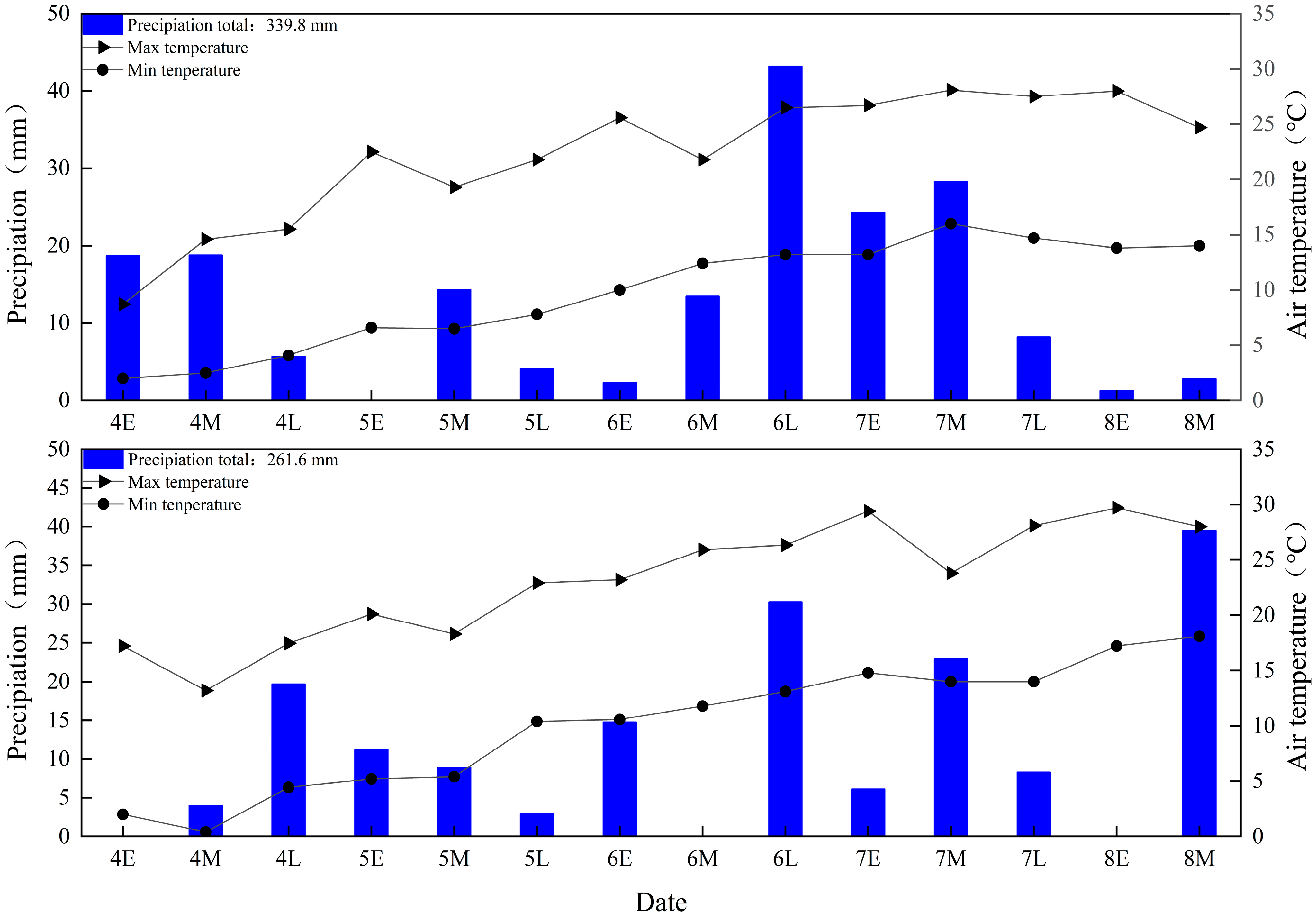
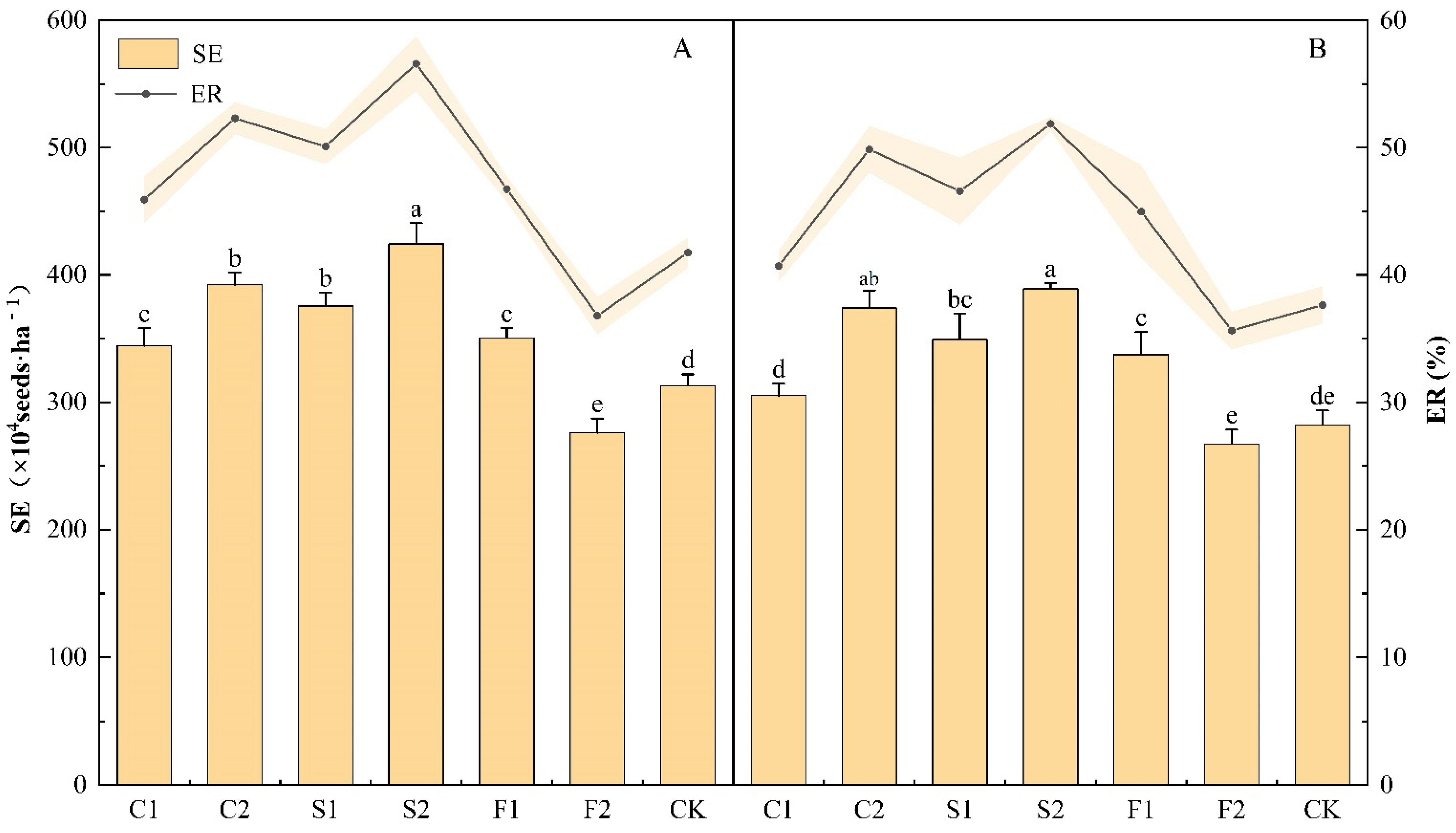

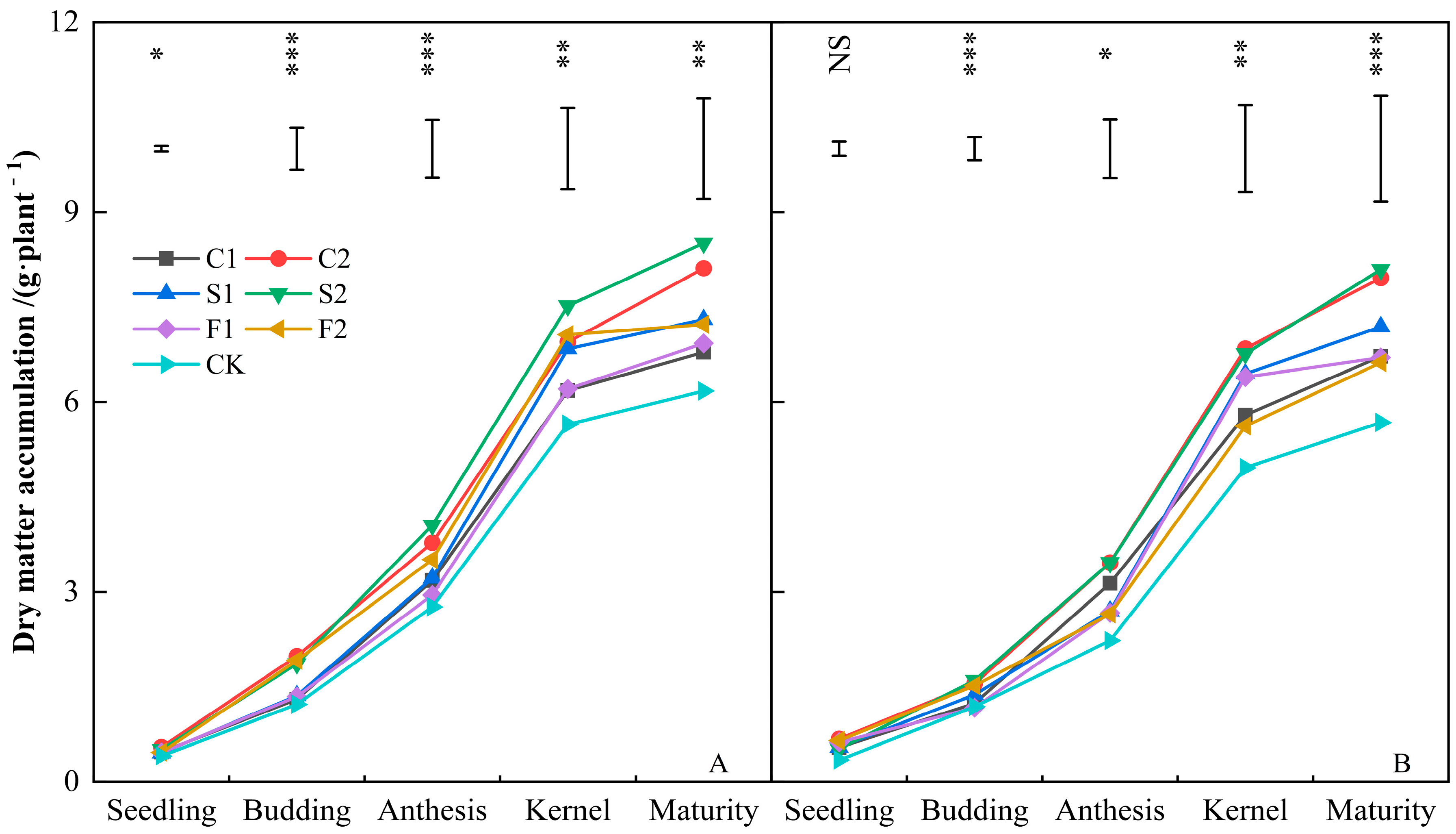

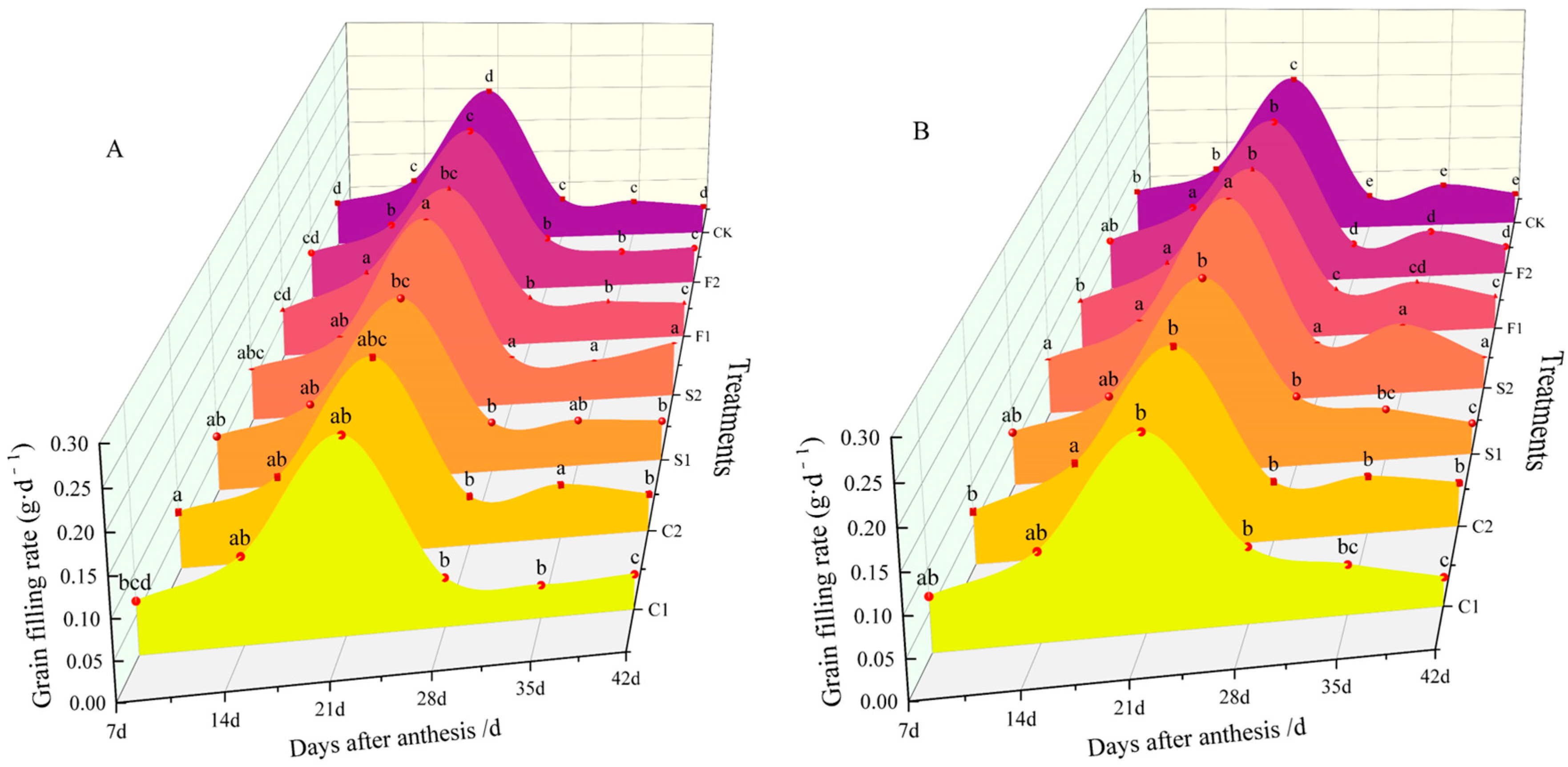

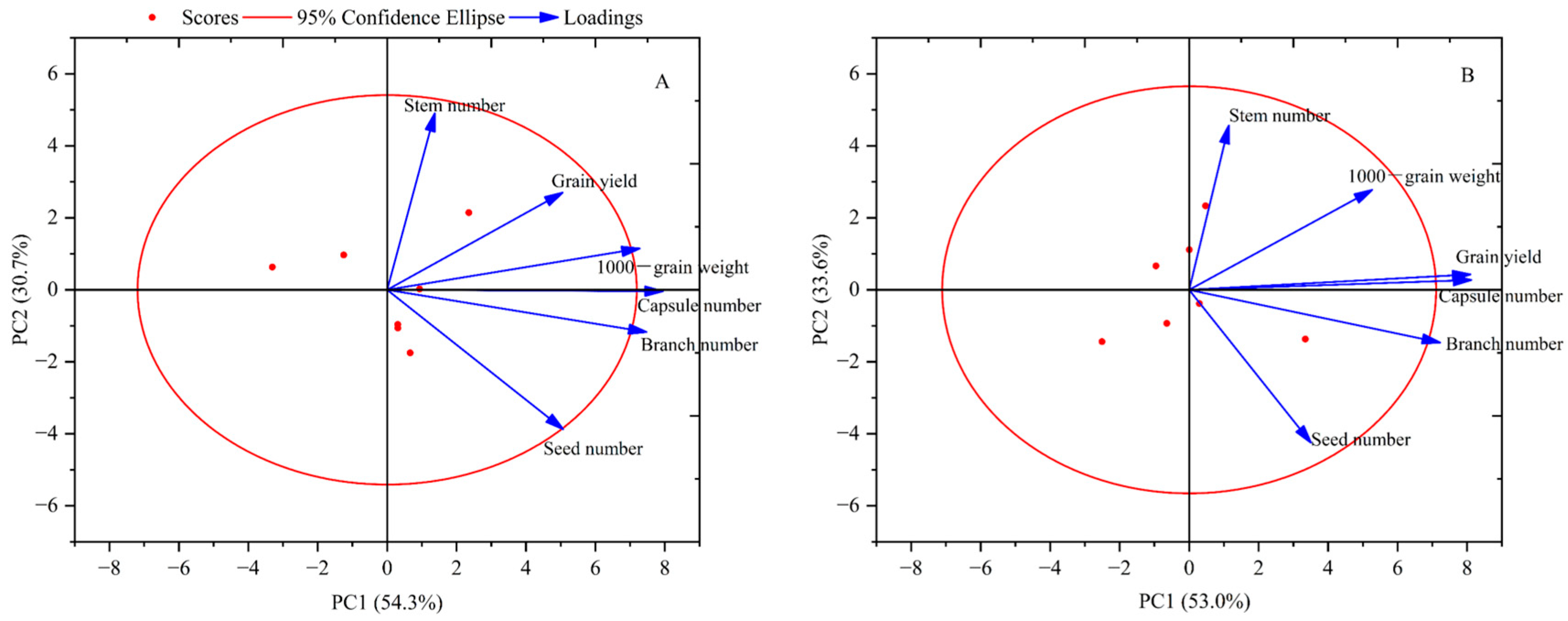

| Year | Organic Matter (g kg−1) | Total N (g N kg−1) | Available N (mg N kg−1) | Total P (g P kg−1) | Available P (mg P kg−1) | Total K (g K kg−1) | Available K (mg K kg−1) | pH |
|---|---|---|---|---|---|---|---|---|
| 2021 | 10.4 | 0.81 | 48.9 | 0.69 | 27.4 | 29.3 | 108 | 8.14 |
| 2022 | 9.21 | 0.75 | 46.9 | 0.68 | 27.1 | 26.9 | 176 | 8.31 |
| Fertilizer | Fertilization Level | Amount of Organic Manure Application | N | P2O5 | K2O |
|---|---|---|---|---|---|
| (t ha−1) | (kg ha−1) | (kg ha−1) | (kg ha−1) | ||
| Poultry manure | C1 | 5.8 | 0 | 6 | 18.2 |
| C2 | 11.6 | 0 | 12 | 36.4 | |
| Chemical fertilizer | F1 | 0 | 112 | 75 | 67.5 |
| F2 | 0 | 225 | 150 | 135 | |
| Sheep manure | S1 | 12.5 | 0 | 12.5 | 11.2 |
| S2 | 25 | 0 | 25 | 22.4 | |
| CK | No fertilizer | 0 | 0 | 0 | 0 |
| Treatment | 7 Days after Anthesis | 14 Days after Anthesis | 21 Days after Anthesis | 28 Days after Anthesis | 35 Days after Anthesis | 42 Days after Anthesis |
|---|---|---|---|---|---|---|
| Y | 0.09 | 6.35 * | 18.13 ** | 39.2 ** | 40.11 ** | 37.04 ** |
| F | 6.89 ** | 6.96 ** | 22.43 ** | 52.22 ** | 27.5 ** | 43.01 ** |
| L | 0.46 | 0.54 | 13.75 ** | 12.35 ** | 10.42 ** | 29.81 ** |
| Y × F | 3.51 * | 0.01 | 0.91 | 9.78 ** | 4.83 ** | 3.71 * |
| Y × L | 3.31 | 3.09 | 1.34 | 0.84 | 0.41 | 0.21 |
| F × L | 2.07 | 2.06 | 9.57 ** | 10.7 ** | 8.68 ** | 19.71 ** |
| Y × F × L | 0.51 | 0.01 | 0.47 | 1.26 | 3.66 * | 3.19 |
| Year | Treatment | Grain Filling Fitting Equation | R2 | F | D/d | V-Ave (g·d−1) | T-Max/d | V-Max (g·d−1) | W-Max/g |
|---|---|---|---|---|---|---|---|---|---|
| 2021 | C1 | y = 4.55/(1 + 32.50e−0.204t) | 0.994 | 788.21 ** | 29.41 | 0.111 | 17.06 | 0.23 | 2.27 |
| C2 | y = 4.70/(1 + 29.89e−0.199t) | 0.988 | 426.70 ** | 30.15 | 0.116 | 17.07 | 0.23 | 2.35 | |
| S1 | y = 4.60/(1 + 33.39e−0.203t) | 0.994 | 772.94 ** | 29.56 | 0.112 | 17.28 | 0.23 | 2.30 | |
| S2 | y = 5.00/(1 + 30.23e−0.197t) | 0.995 | 957.00 ** | 30.46 | 0.122 | 17.30 | 0.25 | 2.50 | |
| F1 | y = 4.41/(1 + 29.65e−0.202t) | 0.989 | 460.76 ** | 29.70 | 0.109 | 16.78 | 0.22 | 2.21 | |
| F2 | y = 4.22/(1 + 29.56e−0.209t) | 0.988 | 453.01 ** | 28.71 | 0.104 | 16.20 | 0.22 | 2.11 | |
| CK | y = 3.88/(1 + 31.17e−0.206t) | 0.986 | 353.97 ** | 29.13 | 0.096 | 16.70 | 0.2 | 1.94 | |
| 2022 | C1 | y = 4.15(1 + 39.98e−0.231t) | 0.992 | 613.32 ** | 25.97 | 0.103 | 15.97 | 0.24 | 2.08 |
| C2 | y = 4.38/(1 + 29.78e−0.201t) | 0.988 | 418.12 ** | 29.85 | 0.108 | 16.88 | 0.22 | 2.19 | |
| S1 | y = 4.28/(1 + 28.30e−0.198t) | 0.986 | 437.01 ** | 30.30 | 0.106 | 16.88 | 0.21 | 2.14 | |
| S2 | y = 4.51/(1 + 32.15e−0.205t) | 0.985 | 304.94 ** | 29.27 | 0.113 | 16.93 | 0.23 | 2.25 | |
| F1 | y = 4.22/(1 + 30.53e−0.208t) | 0.99 | 524.87 ** | 28.85 | 0.105 | 16.44 | 0.22 | 2.11 | |
| F2 | y = 4.22/(1 + 33.10e−0.208t) | 0.991 | 540.12 ** | 28.85 | 0.105 | 16.82 | 0.22 | 2.11 | |
| CK | y = 3.87/(1 + 35.180e−0.213t) | 0.987 | 493.88 ** | 28.17 | 0.096 | 16.72 | 0.21 | 1.94 |
| Year | Treatment | Stem Number/Per | Branch Number of Main Stem/Per | Effective Capsule Number/Per | Seed Number Per Capsule/Seed | 1000-Grain Weight/g | Grain Yield (kg·ha−1) |
|---|---|---|---|---|---|---|---|
| 2021 | C1 | 1.29 d | 7.43 c | 16.33 b | 8.52 a | 8.50 ab | 1242.12 cd |
| C2 | 1.33 d | 7.71 bc | 17.19 b | 8.10 ab | 8.12 c | 1454.63 ab | |
| S1 | 1.67 b | 7.97 bc | 16.62 b | 8.10 ab | 8.52 ab | 1335.83 bc | |
| S2 | 1.98 a | 8.33 ab | 19.52 a | 7.62 bcd | 8.73 a | 1630.31 a | |
| F1 | 1.73 b | 6.33 d | 13.52 c | 7.46 cd | 8.25 bc | 1331.17 bc | |
| F2 | 1.51 c | 8.81 a | 17.18 b | 7.95 abc | 8.32 bc | 1044.72 e | |
| CK | 1.62 bc | 4.52 e | 12.29 c | 7.14 d | 7.97 c | 1116.06 de | |
| 2022 | C1 | 1.69 b | 5.33 ab | 13.44 b | 7.44 ab | 8.17bc | 964.12 bc |
| C2 | 1.90 a | 5.22 b | 14.33 b | 7.11 b | 8.58 ab | 1149.51 b | |
| S1 | 1.46 c | 5.56 ab | 14.33 b | 8.00 ab | 8.22 abc | 1086.04 bc | |
| S2 | 1.23 d | 6.11 a | 16.33 a | 8.89 a | 8.52 abc | 1339.24 a | |
| F1 | 1.67 b | 5.11 b | 13.11 b | 7.89 ab | 8.63 a | 1084.41 bc | |
| F2 | 1.44 c | 5.56 ab | 13.00 b | 8.33 ab | 8.17 bc | 944.64 c | |
| CK | 0.98 e | 4.78 b | 11.44 c | 8.11 ab | 8.12 c | 906.12 c | |
| Y | 0.02 | 195.88 ** | 103.13 ** | 1.24 | 0.08 | 52.65 ** | |
| F | 3.39 * | 27.41 ** | 41.49 ** | 1.09 | 5.25 ** | 15.20 ** | |
| L | 3.10 | 22.79 ** | 46.2 ** | 0.25 | 0.11 | 6.30 * | |
| Y × F | 4.55 * | 9.94 ** | 1.01 | 6.09 ** | 2.31 | 0.82 | |
| Y × L | 0.46 | 7.14 * | 9.59 ** | 1.42 | 0.67 | 0.14 | |
| F × L | 0.24 | 8.56 ** | 3.34 * | 1.62 | 3.50 * | 19.26 ** | |
| Y × F × L | 10.12 ** | 5.62 ** | 5.24 * | 1.30 | 7.37 ** | 0.77 | |
| Year | Treatment | Planting Cost (CNY ha−1) | Yield Increase Rate (%) | ELP (CNY ha−1) | Net Income (CNY ha−1) | ||
|---|---|---|---|---|---|---|---|
| Fertilizer | Other | Total | |||||
| 2021 | C1 | 1740 | 750 | 2490 | 11.30 | 12,288.14 | 9798.14 b |
| C2 | 3480 | 4230 | 30.34 | 14,238.32 | 10,008.32 b | ||
| S1 | 2500 | 3250 | 19.69 | 13,137.90 | 9887.90 b | ||
| S2 | 5000 | 5750 | 46.08 | 15,893.94 | 10,143.94 ab | ||
| F1 | 822 | 1572 | 19.27 | 13,200.60 | 10,432.34 a | ||
| F2 | 1644 | 2394 | −6.39 | 9958.58 | 5172.07 d | ||
| CK | 0 | 750 | 0 | 10,029.01 | 9279.01 c | ||
| 2022 | C1 | 1740 | 1070 | 2810 | 6.40 | 9813.97 | 7003.97 d |
| C2 | 3480 | 4550 | 26.86 | 12,097.51 | 7547.51 c | ||
| S1 | 2500 | 3570 | 19.86 | 11,189.59 | 7619.59 bc | ||
| S2 | 5000 | 6070 | 47.80 | 14,015.54 | 7945.54 ab | ||
| F1 | 822 | 1892 | 19.68 | 11,176.52 | 8088.26 a | ||
| F2 | 1644 | 2714 | 4.25 | 9207.94 | 4101.43 e | ||
| CK | 0 | 1070 | 0 | 8249.46 | 7179.46 d | ||
Disclaimer/Publisher’s Note: The statements, opinions and data contained in all publications are solely those of the individual author(s) and contributor(s) and not of MDPI and/or the editor(s). MDPI and/or the editor(s) disclaim responsibility for any injury to people or property resulting from any ideas, methods, instructions or products referred to in the content. |
© 2023 by the authors. Licensee MDPI, Basel, Switzerland. This article is an open access article distributed under the terms and conditions of the Creative Commons Attribution (CC BY) license (https://creativecommons.org/licenses/by/4.0/).
Share and Cite
Ma, X.; Gao, Y.; Wu, B.; Ma, X.; Wang, Y.; Yan, B.; Cui, Z.; Wen, M.; Zhang, X.; Wang, H. Organic Manure Significantly Promotes the Growth of Oilseed Flax and Improves Its Grain Yield in Dry Areas of the Loess Plateau of China. Agronomy 2023, 13, 2304. https://doi.org/10.3390/agronomy13092304
Ma X, Gao Y, Wu B, Ma X, Wang Y, Yan B, Cui Z, Wen M, Zhang X, Wang H. Organic Manure Significantly Promotes the Growth of Oilseed Flax and Improves Its Grain Yield in Dry Areas of the Loess Plateau of China. Agronomy. 2023; 13(9):2304. https://doi.org/10.3390/agronomy13092304
Chicago/Turabian StyleMa, Xingkang, Yuhong Gao, Bing Wu, Xingbang Ma, Yifan Wang, Bin Yan, Zhengjun Cui, Ming Wen, Xue Zhang, and Haidi Wang. 2023. "Organic Manure Significantly Promotes the Growth of Oilseed Flax and Improves Its Grain Yield in Dry Areas of the Loess Plateau of China" Agronomy 13, no. 9: 2304. https://doi.org/10.3390/agronomy13092304





